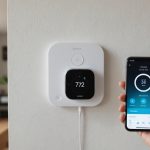Introduction to Smartphone-Controlled Heating Systems
With the rise of smartphone integration in various home applications, heating systems have also undergone a technological makeover. Today’s smart thermostats offer a convenient way to manage your home’s climate, making temperature management more efficient and tailored to individual preferences.
Smartphone heating control allows users to adjust their home’s temperature directly from their mobile devices, no matter where they are. This level of control means you can warm up the house before you arrive or reduce heating when it’s not needed, thus saving energy and reducing bills.
Also read : Maximizing your smartphone”s capabilities: essential tips for turning it into an effective smart home hub
Benefits of Using Technology for Temperature Control
Smartphone heating control brings several advantages. It provides:
- Convenience: Easily adjust settings without having to be near the thermostat.
- Energy efficiency: Optimize heating schedules, reducing waste and cost.
- Personalization: Adapt settings to different times or personal comfort levels.
Key Features to Look for in Smart Heating Systems
When choosing a smart heating system, consider the following features:
Additional reading : Mastering smart home management: ultimate tips for effortless control via your smartphone
- Compatibility with existing HVAC systems.
- User-friendly app interfaces.
- Energy tracking to monitor usage.
- Integration with other smart home devices for a cohesive ecosystem.
Investing in a smart heating system with comprehensive smartphone control can offer unprecedented convenience and customization while contributing to more sustainable energy practices.
Types of Smartphone-Compatible Heating Solutions
Understanding the types of smart heaters available transforms the way we approach home heating. At the core, these solutions include smart thermostats and smart radiator valves.
Smart thermostats grant you control over your heating through your smartphone, offering simplicity and efficiency. They come equipped with learning capabilities that program themselves based on your habits. Smart radiator valves, on the other hand, allow for room-specific adjustments. This flexibility fosters precise smart zone control, giving you personalized comfort while potentially saving energy.
Smart zone control systems provide a nuanced method of heating by dividing your home into different zones, each managed independently. This allows you to heat only the spaces you frequently use, ensuring optimal efficiency.
When considering installation, the choice between wireless and wired systems also matters. Wireless solutions are typically easier to install and can be less intrusive, making them a practical choice for many homes. However, wired systems might appeal for their reliability in enduring demanding setups.
Ultimately, selecting the right system depends on individual needs and home structures. Enabling energy-efficient, smart heating technologies in your home can lead to enhanced comfort and cost savings.
Installation Tips for Smart Heating Systems
Embarking on the journey of integrating a smart heating system in your home can be a transformative experience. To ensure a seamless transition, consider whether a DIY thermostat setup or a professional installation is right for you. Let’s explore how to navigate these options effectively.
For a DIY approach, begin with this step-by-step guide:
- Turn off the power to your heating system to prevent any electrical mishaps.
- Remove the old thermostat, taking note of the wiring configuration.
- Install the smart thermostat base plate and connect the wires to the appropriate terminals as per the manual.
- Secure the thermostat unit and power on your system.
Be cautious of common pitfalls such as incorrect wiring or failing to connect to the Wi-Fi network. These might cause the system to malfunction.
For more complex systems, the importance of professional installation cannot be underestimated. Advanced systems may require expertise in integrating with existing HVAC systems and ensuring optimal performance. A professional installer can guarantee not only accuracy but also efficiency in your heating’s functionality.
Whether you opt for DIY or a professional, the core lies in understanding the intricacies of your smart heating system to make informed choices.
User Reviews and Case Studies
Smart heating systems have revolutionised the way households manage temperature, offering both energy efficiency and enhanced comfort. In numerous smart heating reviews, users highlight notable savings on energy bills, often seeing a substantial reduction in costs. This economic advantage makes these systems appealing to a broad audience.
User experiences showcase that integrating smart thermostats with zoned heating has improved temperature management. For example, families with varied daily routines can customise each room’s warmth to suit individual needs, ensuring both comfort and reduced wastage. This adaptability aligns with reviews that praise the user-friendly interfaces of many devices, which simplify heating control with intuitive designs.
Real-life case studies on heating control further illustrate these benefits. In one example, a household in London reported a 20% drop in annual heating expenses. This change resulted from the strategic application of zone temperature control, which allowed specific rooms to be heated only when in use. Such case studies confirm that these systems are not merely technological novelties but practical tools for everyday life.
Adding to this, the analysis of these systems often underlines the precision with which they maintain consistent temperatures, thereby enhancing comfort without a spike in energy use.
Practical Strategies for Efficient Heating Management
Implementing efficient heating management can lead to substantial savings on energy bills. A good place to start is by setting up heating schedules and zones tailored to your daily routine. By designating specific times for different areas to be heated, you can avoid unnecessary consumption.
Smartphone apps are a game-changer in this domain. They offer seamless control over heating, allowing you to remotely adjust temperature settings from anywhere. Whether you’re out for the day or coming home earlier than expected, these apps ensure your home is always at the perfect temperature when you need it. Leveraging such technology not only enhances energy-saving tips but also adds convenience to everyday life.
Monitoring is another cornerstone of effective heating management. Set regular checks to ensure everything is running efficiently. Automated heating systems often come with features that track energy usage. Use these metrics to fine-tune your settings for optimal performance. Adjusting based on the insights gained from these systems can lead to further energy savings.
Incorporate these strategies into your heating routine to enjoy the dual benefits of comfort and cost-efficiency. By embracing tools and habits that promote efficient heating, you’ll achieve a more sustainable and budget-friendly environment.
Visual Aids and Demonstrations
Understanding modern heating technology can be quite challenging. This is where visual aids become invaluable, assisting in making complex concepts easier to grasp. One might wonder, “Why are visual aids important?” Simply put, they enhance comprehension by offering a clear, visual representation of components and processes.
For those setting up their **smart thermostats*, accessing **installation videos** is beneficial. These videos provide a step-by-step walkthrough, ensuring that users correctly install and configure their devices. Channels like Brilliant DIY on platforms like YouTube offer a wealth of such resources, guiding from unboxing to final setup.
Moreover, mastering zone control—a key feature of many heating systems—can be simplified using detailed diagrams. These diagrams effectively illustrate how different zones within a building can be heated independently, showcasing the network of thermostats, valves, and vents required.
Smart thermostat tutorials further aid in exploring unique features and functionalities of various models. Whether you’re trying to achieve energy efficiency or comfort, these tutorials offer insights into settings customization. Thus, combining these visual aids and instruction-rich materials can significantly enhance one’s ability to manage and control a heating system efficiently.
The Impact of Smart Heating on Comfort and Energy Savings
Discover how smart heating systems revolutionize indoor comfort and offer substantial energy savings. These innovative systems consistently optimize temperature, ensuring that each room is heated appropriately, eliminating cold spots and overheating.
Enhanced Comfort Through Smart Systems
Smart heating comfort is achieved via personalized control, making it possible to adjust the temperature according to specific preferences and routines. This customization is crucial for creating an environment where every family member can feel at ease. For instance, a smart thermostat can learn household habits, automatically setting temperatures to fit daily activities, resulting in a cozy and welcoming home ambiance.
Energy Efficiency and Zone Control
One of the key features is the ability to control temperature by zones, which prevents unnecessary heating of unused areas. This zone temperature control not only heightens comfort but also prevents waste, leading to noticeably lower utility bills. Users can focus energy on occupied spaces, translating into substantial home heating savings.
Long-term Benefits of Smart Heating Technology
Adopting smart heating solutions provides not only immediate advantages but also long-term benefits. Energy efficiency measures reduce carbon footprints, helping homeowners contribute to a more sustainable environment. Furthermore, the improvement in energy costs amortizes the investment in smart systems over time, making it a pragmatic choice for the future.











